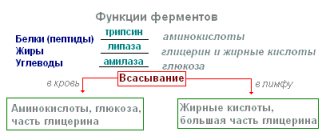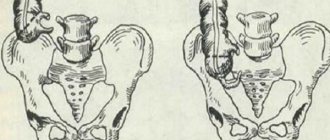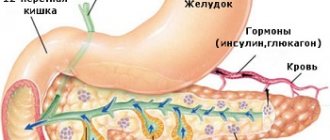Enzymes or enzymes are important participants in the digestive process that help us digest food well and absorb its beneficial substances, turning them from complex to simple. By and large, enzymes are chemical substances (proteins) that speed up the digestion process, i.e. are its catalyst.
Obviously, each of us at least once in our lives has encountered such unpleasant health phenomena as heaviness in the stomach, stagnation of food in the stomach and intestines, diarrhea or constipation. Almost each of these phenomena is caused by malfunctions of digestive enzymes. Another not-so-good news is that as we age, the human body produces less and less of its own enzymes to digest food, which can significantly affect health and well-being.
Digestive enzymes - how they work
Let us immediately note: certain organs of the human body also produce certain enzymes. As soon as the enzyme enters the food, it (in accordance with its “specialization”) begins to crush it (at the molecular level) into smaller particles - molecules of substances that are simpler in chemical structure.
This is necessary so that food is better and easier to digest in the intestines. For example, enzymes acting on proteins (proteases, peptidases) break down complex, huge protein molecules into smaller molecules - peptides and amino acids; enzymes that break down carbohydrates, convert them into simple sugars (for example, glucose); enzymes for fats - lipases - “conjure” over lipids (fats), forming fatty acids and cholesterol from them.
Thanks to the work of enzymes, the resulting components will subsequently be able to penetrate the intestinal barrier, enter the blood and be transported with the blood to all organs of the body.
Best Sources of Digestive Enzymes
Many raw plants, such as raw fruits and vegetables, contain enzymes that help in their digestion. For example, pineapple, papaya, apples and many other plants contain beneficial enzymes. But when these foods are grown in depleted soils or are highly processed, the enzymes are missing or destroyed.
Digestive enzyme supplements come primarily from three sources:
- The fruit source is usually pineapple or papaya. Bromelain is an enzyme derived from pineapple that breaks down a wide range of proteins, has anti-inflammatory properties and can withstand a wide range of pH (acidic/alkaline). Papain is another enzyme that is obtained from raw papaya. It works great to support the breakdown of small and large proteins.
- Animal origin - including bovine or porcine pancreatin.
- Plant Sources – Derived from probiotics, yeast and fungi.
Papaya is a source of the proteolytic enzyme papain.
What does natural digestive enzymes mean?
Many digestive enzymes available on the market are “natural” because they are derived from plants or animals. Digestive enzyme products can be a dizzying array of ingredients, making it difficult to know which ones are the best digestive enzymes. But still, enzymes obtained from plant sources are preferable.
Some products contain only plant enzymes, which are intended for vegetarians and vegans. They typically contain bromelain, derived from pineapple, and many include the enzyme papain from papaya. Products designed specifically for vegans contain pancreatin derived from Aspergillus niger. It is a mushroom-based fermented product, rather than an enzyme derived from bovine or pig bile, which are the usual sources.
In addition, some dietary supplements add additional herbs and spices. Amla (gooseberry) extract is often included, which is not an enzyme but an herbal remedy from Ayurvedic medicine taken for overall well-being. It is believed to enhance the functions of digestive enzymes.
Pancreatic Enzymes vs. Digestive Enzymes
“Digestive enzymes”—also called gastric enzymes—are a broad term that includes pancreatic enzymes, plant enzymes, and fungal enzymes. Pancreatic enzymes are found in the pancreatic juices that most people produce daily. These juices contain pancreatic enzymes, which aid digestion, and bicarbonate, which neutralizes stomach acid as it enters the small intestine. The names of pancreatic enzymes usually end in -in (for example, trypsin or pepsin). While other digestive enzymes usually end in -ase or -ose (eg lactose, sucrose, fructose).
These enzymes, primarily aimed at digesting fats and amino acids, include:
- lipase - converts triglycerides into fatty acids and glycerol,
- amylase - converts carbohydrates into simple sugars,
- elastase - decomposes elastin protein,
- trypsin - converts proteins into amino acids,
- chymotrypsin - converts proteins into amino acids,
- nuclease - convert nucleic acids into nucleotides and nucleosides,
- phospholipase - converts phospholipids into fatty acids.
The main enzymatic structures of the human digestive system are the salivary glands, stomach, pancreas, liver and small intestine. The pancreas produces bile salts. They consist of water, electrolytes, amino acids, cholesterol, fats and bilirubin - all of which come from the liver through the gallbladder. These are choline and chenodeoxycholic acids, which, in combination with the amino acids glycine or taurine, themselves produce bile salts. Bile salts break down fats from food, which allows the enzyme lipase to contract further.
The duodenum (the first and shortest segment of the small intestine) is also a busy place when it comes to digestion. Amino acids are extracted from proteins, fatty acids and cholesterol from fats, simple sugars from carbohydrates. Nuclease breaks down the nucleic acids needed for DNA into nucleotides.
All macronutrients are broken down into molecules small enough to enter the bloodstream and speed up the metabolism, allowing it to function efficiently. Micronutrients, if they have not already been broken down in the stomach, are also released and enter the bloodstream.
When it comes to sugar metabolism, intestinal enzymes include the following key (but complex) processes:
- Aminopeptidases break down peptides into amino acids.
- Lactase, milk sugar, converts lactose into glucose.
- Cholecystokinin promotes the absorption of proteins and fats.
- Secretin, as a hormone, controls the secretion of the duodenum.
- Sucrase converts sucrose into disaccharides and monosaccharides.
- Maltase converts maltose into glucose.
- Isomaltase converts isomaltose.
Enzyme types
For each type of food consumed by humans, there are certain types of digestive enzymes.
Enzymes for carbohydrates
- maltase - breaks down maltose (malt sugar) into glucose molecules, present in saliva and in pancreatic secretions
- amylase - breaks down starch into glucose molecules, also present in saliva and in pancreatic secretion
- lactase - breaks down milk sugar (lactose) into galactose and glucose, secreted in the small intestine
Proteolytic enzymes (for protein breakdown)
- pepsin - produced by cells of the gastric mucosa, present in gastric juice, converts proteins into amino acids
- trypsin - produced by the pancreas, breaks down proteins and peptides
- peptidases - enzymes that break down peptide bonds in protein molecules into short peptides and amino acids
Enzymes for fats
- lipases - enzymes that help break down and digest fats
Digestive enzymes in saliva
The first stage of digestion is the passage of food through the mouth and esophagus. Here the food will be pre-grinded by the teeth.
When food comes into contact with the mucous membrane of the oral cavity, saliva is released through an unconditioned reflex. Saliva and other digestive juices are rich in digestive enzymes, often secreted by the sight or smell of food, although this is already associated with the body's conditioned reflexes.
The oral cavity produces up to 1.5 liters of saliva per day . This occurs due to the salivary glands. Saliva contains an enzyme for the breakdown of polysaccharides - alpha-amylase and mucin.
Where are enzymes produced?
Digestive enzymes are produced by various organs of the human body:
- Salivary enzymes - produced by the salivary glands (amylase, maltase, lipase...).
- Stomach enzymes - produced by the gastric mucosa (pepsin, lipase, cathepsin, renin...).
- Liver enzymes (sulfotransferase, esterases...), which are mixed with bile acids, are sent to the duodenum and help break down fats into healthy cholesterol.
- Pancreatic enzymes (amylase, lipase, trypsin, peptidases...) are produced in the form of pancreatic juice, which then also enters the duodenum.
The small intestine also contains enzymes (maltase, sucrase, lactase, peptidase...), the action of which on food allows the process of digestion of carbohydrates and proteins to be completed.
Every time a person is about to eat, or even looks at food, the biochemical process of formation of digestive enzymes is activated; they are secreted through reflex mechanisms. The first enzymes for processing food are secreted by saliva; then the secretion of hydrochloric acid begins in the stomach as soon as food enters there, and the beginning of the secretion of gastric juices stimulates the production of liver and pancreatic enzymes...
When Do You Need Digestive Enzyme Supplements?
In order for nutrients to be absorbed, they must be adequately digested. If any of the above processes of digestive enzyme secretion are disrupted, it will lead to malabsorption and hence nutritional deficiencies. This is especially true for impaired exocrine pancreatic function.
Predispose to this condition:
- chronic pancreatitis
- cystic fibrosis
- blockage of the pancreatic or gallbladder duct
This leads to digestive and absorption problems, so it is recommended to take pancreatic enzymes in such cases.
The role of enzymes in human life
To understand how important these little helpers are in our body, it is enough to understand the meaning of one very smart idea: good health begins with good digestion.
Many health problems begin with poor digestive absorption of nutrients, the main reason for this phenomenon is the insufficiency or absence of certain enzymes in the human body. Even if you eat well and the food consists only of high-quality products, the final process of absorption of nutrients depends on enzymes and their sufficient quantity.
What you digest with an enzyme deficiency will be very different from what you eat. Poor digestion cannot be corrected by changing the food intake or taking dietary supplements. Health disorders begin with poor absorption of amino acids, the first signs of this process are fatigue, bad mood due to the lack of neurotransmitters (products for depression), decreased production of hormones, skin problems, decreased immunity, etc.
Their role in food digestion
Enzymes play an important biological role in the metabolism of the body and, first of all, in the digestion of food. If they are deficient or absent, full absorption of all nutrients is almost impossible.
Digestion of food begins in the oral cavity. The salivary glands secrete amylase, a salivary enzyme that, during the process of chewing food, breaks down starch into soluble sugars (maltose, dextrins, maltriose).
The second stage of digestion is treatment with gastric enzymes. The main enzyme that works in the stomach is pepsin. It destroys peptide bonds of high molecular weight proteins, resulting in the formation of peptides.
In the lumen of the duodenum, pancreatic juice enzymes are active. The secretion occurs through the large papilla, which opens in the intestinal wall.
The following classification of pancreatic (pancreatic) enzymes is distinguished:
- Proteases. They are divided into trypsin (acts similarly to pepsin), chymotrypsin (breaks down animal and plant proteins), carboxypeptidase, elastase (hydrolyze elastin).
- Nucleases. They break the bonds between DNA and RNA chains.
- Steapsin. Ensures the breakdown of fats.
- Amylase. Destroys starch and glycogen, promoting the formation of simple carbohydrate particles.
- Lipase. It primarily affects fats that are released into the lumen of the gastrointestinal tract along with bile. Has tropism for triacylglycerides.
Food entering the loops of the small intestine is exposed to an even more massive list of enzymatic substances, among which are:
- Peptidases. Enteropeptidase promotes the activation of trypsinogen (which was secreted by the pancreas), resulting in the formation of trypsin, which breaks down high-molecular proteins and peptides. The group of peptidases also includes alanine aminopeptidase, which destroys sulfide bonds in peptides formed after exposure to gastric juice proteases.
- Lipase.
- Erepsin (hydrolyzes proteins).
- Enzymes that break down disaccharide formations into monosaccharides. Sucrase breaks down sucrose to form glucose and fructose, maltase - maltose to glucose, isomaltase - maltose and isomaltose (maltose isomer) to glucose, lactase - lactose to galactose and glucose.
It is important to note that representatives of the beneficial bacterial intestinal flora take an active part in the processes of digestion of food particles.
Microorganisms that live in the human large intestine secrete digestive enzymes that help digest certain foods. The most effective are lactobacilli, bifidobacteria and E. coli (belongs to the Enterobacteriaceae family).
American studies have found that an increase in the population of lacto- and bifidobacteria in the microflora of the gastrointestinal tract increases the rate of lactose digestion.
It is important to note that according to scientists, people with lactose intolerance (up to 25% of the world's population suffers from this pathology in varying degrees of severity) can safely consume up to 18 g of lactose.
Scientists recommend including probiotics and foods to improve food digestion.
In separate articles, we looked at what probiotics are and described their 8 beneficial properties.
Thus, many enzymes work in the lumen of the gastrointestinal tract, each of which performs a specific function - it breaks down certain groups of substances (proteins, fats, carbohydrates, etc.). The coordinated work of all protein molecules ensures complete absorption of food.
Enzyme deficiency - distinctive signs
The main sign of digestive enzyme deficiency is, of course, complaints of poor health due to poor functioning of the digestive system. Typically the consequences appear as:
- heaviness and pain in the abdomen after eating
- bloating, belching
- excess gas formation
- floating or oily food debris in stool
We can also aggravate the decrease in the production of digestive enzymes through our own harmful eating habits.
1. Reducing the diet of raw foods leads to a significant decrease in the level of enzymes in saliva.
2. The processed foods that we prefer in the modern world deplete the pancreas because it must produce more enzymes to process it - the natural enzymes that were contained in foods before they were cooked are destroyed by high temperature.
This situation is evidenced by experiments conducted by scientists on animals. Those of them who were fed foods deficient in enzymes (consequences of heat treatment) had problems with the pancreas; it was working under overload. Another experiment showed that when eating raw foods, the secretion of salivary enzymes is not so active, since they are replaced by natural enzymes contained in such food.
Causes and symptoms of deficiency
Various diseases of the digestive system lead to enzyme deficiency.
The most important organ for maintaining food absorption processes is the pancreas. Unfortunately, up to 27% of the population experience problems with this organ. The most common pathologies include: chronic and acute pancreatitis, cystic fibrosis, pancreatic cancer. For 7 foods that are good for the pancreas, see a separate article.
In second place in frequency are exacerbations of chronic abnormalities of the digestive tube (chronic gastritis and duodenitis, biliary dyskinesia, cholecystitis).
The first symptoms of digestive enzyme deficiency are usually:
- heartburn and belching;
- flatulence (excessive formation of gas in the intestinal lumen);
- bowel disorders such as diarrhea or constipation;
- spasmodic pain in any part of the abdomen;
- general weakness, chronic fatigue, drowsiness, decreased performance.
If the above symptoms appear, it is recommended to consult a doctor.
Decreased enzyme activity - causes
1. Food is not chewed thoroughly, food is absorbed too quickly - there is no stimulation of the production of enzymes in other digestive organs.
2. The body does not have enough necessary nutrients (vitamins, minerals, microelements) for a certain type of enzyme to work, and as a result, the enzyme does not work.
3. Stomach acidity is reduced - the production of enzymes, which is catalyzed by hydrochloric acid, is reduced.
4. Food consumed - nuts, seeds, whole grains, etc. - contains enzyme inhibitors.
5. A person is often in a state of stress, which depletes the production of enzymes.
6. The body is susceptible to intoxication with heavy metals, because of this, enzymatic reactions fade away.
7. Genetic digestive defects (for example, there is no synthesis of lactase, which helps digest lactose coming from milk).
Which digestive enzymes should you choose?
If you are going to take enzymes on an ongoing basis, then it is better to choose plant enzymes.
If you are going to take it occasionally, then you can use any, but in my opinion, herbal ones are still better.
It is best to choose digestive enzyme complexes that contain all the essential enzymes.
MRM, Digest-All, 100 Vegetarian Capsules
Contains all essential enzymes, plus mint and triphala to improve digestion.
Now Foods, Optimal Digestive System, 90 Veggie Capsules
Contains all the necessary enzymes that help break down almost any food, including legumes.
Now Foods, Plant Based Enzymes, 240 Veggie Capsules
Plant enzymes papain, bromelain, amylase, lipase, protease, etc.
And these are excellent ones - Enzymedica, Digest Basic, basic enzyme formula, 90 capsules. They also help break down legumes and fruits
Here is another good complex from iHerb’s own brand - California Gold Nutrition broad spectrum digestive enzymes.
If there are problems with the gallbladder , then it is better to choose enzymes that contain a large amount of lipase and bile salts.
These are good complexes:
- Jarrow Formulas Bile Acid Factors
- Houston Enzymes Lypazyme
If you have low gastric acidity, you MUST take Betaine Pepsin!! !
With age, stomach acidity decreases, plus almost ALL patients with AIT have low acidity. This means that there is not enough gastric juice in the stomach to digest food. The stomach needs an acidic environment to fully digest food, and also to prevent bacteria and yeast from multiplying and multiplying.
✔ If the acidity of the stomach is low, then the food is not completely digested and hello leaky gut syndrome.
✔ If the acidity is low, then bacteria and pathogens can calmly and unhindered multiply and multiply, and hello bacterial overgrowth (SIBO), which leads to imbalance and many problems.
✔ Plus, if acidity is low, then vitamins and minerals are NOT absorbed properly and deficiencies arise, which can also cause a huge number of problems with the body as a whole.
Digestive Enzymes for Gluten Intolerance - Now Foods, Gluten Digest, 60 Veggie Capsules
and these are
California Gold Nutrition.
Contains endopeptidase, which helps break down gluten.
I now have these enzymes - Zenwise Health. Very good. They help digest food and keep my stomach from grumbling.
How to Increase Digestive Enzymes
Enzymes from food
The “main violin” here is played by enzymes that come with fresh and raw foods containing enzymes that are important for digestion. Introduce raw and unprocessed foods into your diet - raw fruits and vegetables, sources of enzymes: ginger, aloe vera, mango, kiwi, pineapples, papaya... The last two fruits are rich in proteolytic enzymes and help digest proteins better. There are many enzymes in sprouted seeds.
Enzymes from food - kombucha (kombucha)
Another storehouse of enzymes is fermented foods: sauerkraut, pickled ginger, apple cider vinegar, kefir, kombucha, pickles, capers, olives, etc.
Enzyme Supplements
Enzyme supplements are made from animal enzymes. They can improve your well-being and the process of digesting food, but they should be taken on the recommendation and under the supervision of a gastroenterologist.
Effect of age
As a person ages, the acidity of the stomach decreases, which in turn leads to a decrease in the production of enzymes. However, this picture is observed against the background of frequent occurrence of acid reflux of the esophagus, you should be aware of this.
Unfortunately, today it has become a common fact that the level of acidity in the stomach decreases long before the onset of middle age. Obviously, this is due to stress, a massive craze for fast food, and the lack of raw food and unprocessed thermally processed foods in the diet. A decrease in acidity leads to the same disastrous consequences - digestive disorders.
Scheme of enzyme action
Enzymes are biological catalysts that have the ability to activate various chemical reactions occurring in a living organism. They are protein in nature. Enzymes is a synonym for the term enzymes.
The action of enzymes is strictly specific, that is, each enzyme catalyzes only one or several related chemical reactions.
Their name consists of the name of the substance on which they act and the ending “ase”.
Examples
:
- enzyme that breaks down sucrose > sucrose
- enzyme that breaks down lactose > lactase
The name can consist of the name of the substance on which the enzyme acts, plus the type of reaction and the ending “ase”
Example
:
- enzyme that breaks down lactate in the process of DEHYDROGENATION > lactate dehydrogenase
An enzyme may have a trivial name
Examples
:
- pepsin;
- thrombin;
- renin
Main functions of enzymes:
- Accelerate the transformation of substances entering the body and formed during the metabolic process (to renew cellular structures, to provide processes with energy, etc.).
- Regulate biochemical processes (for example, the implementation of genetic information).
We recommend
“Nutrition for a healthy lifestyle: healthy foods, life hacks, menus” Read more
Enzyme action diagram:
- Formation of an enzyme-substrate complex.
- Transformation of a substrate into a product: breaking of old bonds, formation of new ones.
- Release of the product from the complex.
Features of enzymes:
- Enzymes are very active. An insignificant dose of them is enough to transform a huge amount of matter from one state to another.
- Enzymes are sensitive to temperature changes. Enzymes exhibit their highest activity at a temperature of 40–50 °C. Therefore, to prevent spoilage, products are stored in the cold or subjected to heat treatment.
- Enzymes are well preserved at low temperatures. They are destroyed (denaturing) at temperatures above 55-60 0C.
- Enzymes are pH dependent. Each enzyme has its own pH optimum: pepsin: pH=1.5-2; most enzymes pH=6-8; arginase pH=10-11.
- Enzymes are formed in a living cell, but are capable of performing catalytic functions outside its boundaries.
- Enzymes can be active outside the cell and outside the body.
Enzyme activators:
- Organic
: bile acids, glutathione, cysteine, vitamin C.
- Inorganic
: hydrochloric acid, ions of many metals.
Enzyme inhibitors:
- Reversible inhibition
. Often these substrate-like substances are used as medicines.
- Irreversible inhibition
: concentrated acids and alkalis, heavy metal salts, ultraviolet irradiation, cellular poisons.
How to improve the production of digestive enzymes
Of course, solving such a difficult task requires an integrated approach. Traditional helpers that stimulate the production of digestive juices are some plants with a bitter taste (natural bitters): gentian, dandelion, turmeric, chicory, red and black hot pepper...
To start the process of enzyme production and prepare the digestive system for good work, practice eating salads of fresh vegetables and herbs at the very beginning of meals.
To keep your digestive system in shape, make it a habit to include raw, unprocessed foods daily, drink enough water, avoid stress, and engage in moderate exercise to stay in good physical shape...
Find out more: 1. Ayurveda and digestion - how to eat right 2. How to improve digestion 3. Principles of proper nutrition
Enzyme activity. When is the best time to take them?
Two options: during meals and after meals, but after meals if discomfort in the intestines develops. Technological ways to improve enzyme efficiency: Most digestive enzymes are active in a very narrow pH range, since the pH of the human gastrointestinal tract varies from acidic to alkaline. For this reason, monocomplexes (containing one enzyme) may be ineffective, since their effect does not extend to the entire digestive tract. An enzyme supplement that is beneficial in one part of the digestive system may be completely inactive in another. To solve the issue of enzyme efficiency, Artlife’s “Biocascade Enzyme Complex” used innovative technology for multi-structural tablet construction. Enzymes are specifically located at different levels of the tablet depending on the order in which they are released in the body. Enzymes are released sequentially in the right places, regulate digestion throughout the entire gastrointestinal tract and reflexively stimulate the production of one’s own digestive juices in a vertical manner. Thanks to this algorithm, high bioavailability and maximum effect of the complex are achieved.
Functions of the colon
Main functions:
- Completion of digestion processes.
- Absorption of water and minerals, B vitamins, fiber hydrolysis products.
- Mechanical movement of feces.
- Endocrine activity.
- Immune – an abundance of diffuse immune tissue.
The large intestine is a breeding area for microorganisms. Most inhabitants are anaerobic. Increase in quantity from the stomach to the distal gastrointestinal tract.
Degradation of carbohydrates and breakdown of proteins: CO2, methane, hydrogen sulfide, toxic substances (phenol, indole, cresol).
When antibiotics are used, the microbial landscape changes due to the proliferation of yeast, staphylococci, clostridia, etc.
Colonic motility is provided by:
- Accumulation of intestinal contents.
- Absorption of water and electrolytes.
- Formation of feces.
- Removing feces.
Normally, chyme flows in only one direction. And bacterial contamination is impossible
After the stomach, food enters the small intestine, and from there into the large intestine. With increased intra-abdominal pressure, the valve between the small and large intestines may close.
The large intestine consists of the cecum, colon, sigmoid and rectum. The cecum is involved in digestion, unlike the colon, which is mainly responsible for the absorption of fluids and electrolytes.
Features of the colon:
- 3 muscle bands of 1 cm each: mesenteric, omental and free.
- Haustra - protrusion.
- Omental processes – 3 – 5 cm.
- Mucosa – transverse semilunar folds 1–2 cm.
- In the thickness of the mucous membrane there are 7.5-12 million colonic glands (Lieberkühn's crypts), which perform not only secretory, but also absorption functions.
- Among them there are EC cells (produce serotonin and melatonin), D1 cells (secrete vasointestinal polypeptide), A cells (secrete glucagon).
- In the mucous membrane of the colon there are 5.5-6 thousand single lymphoid nodules, lymphoid and mast cells, and sometimes a few eosinophils and neutrophils.











